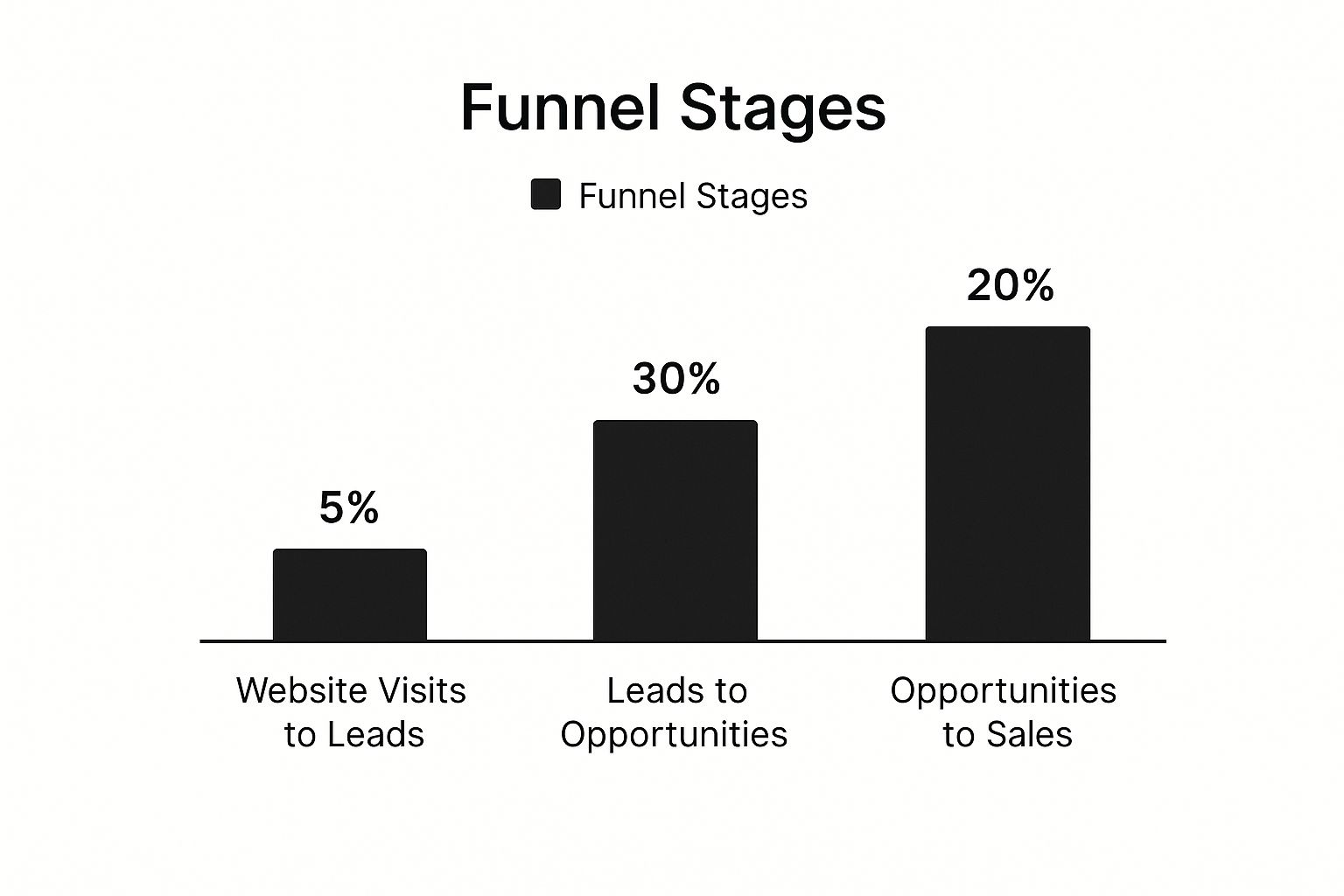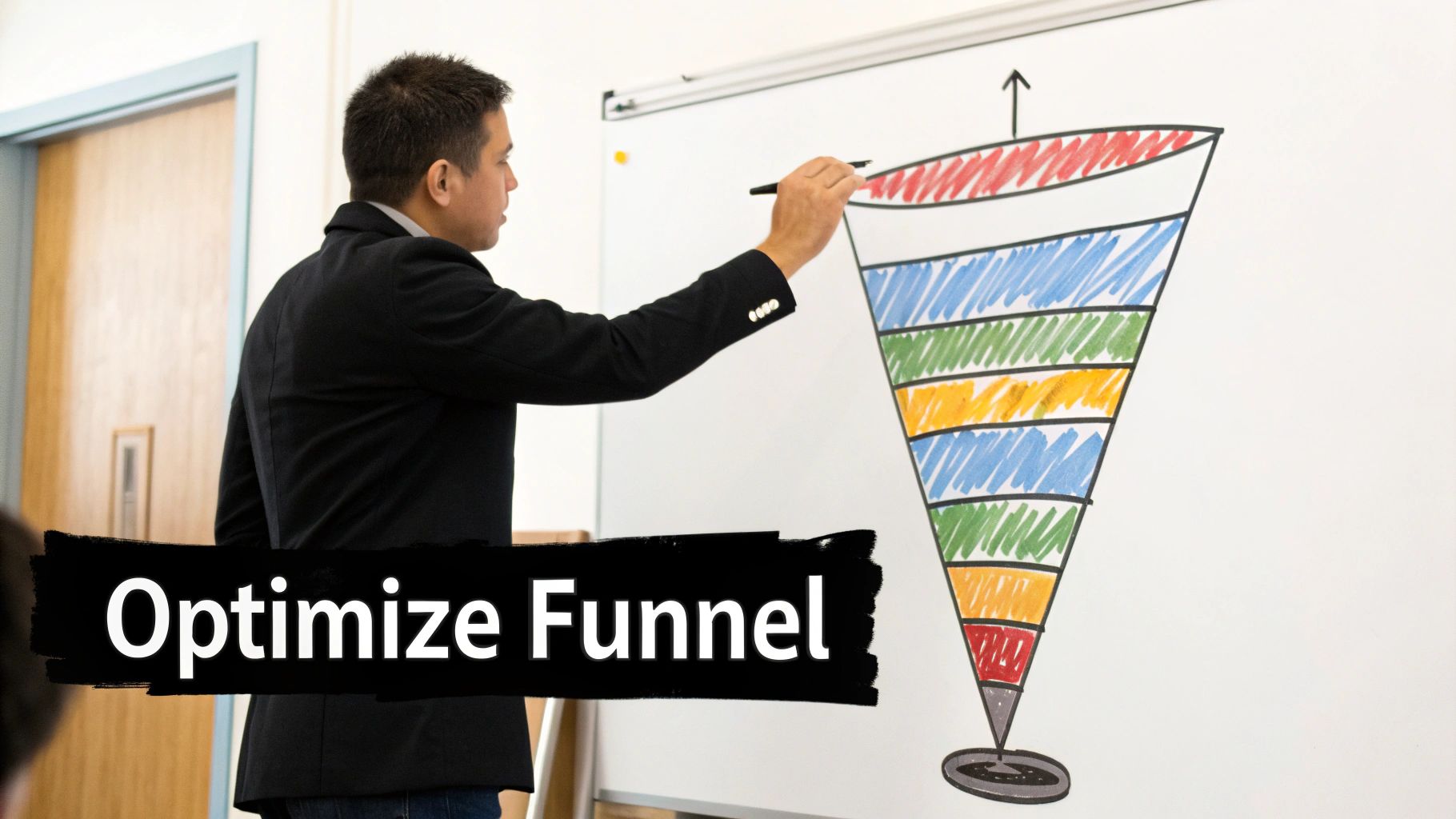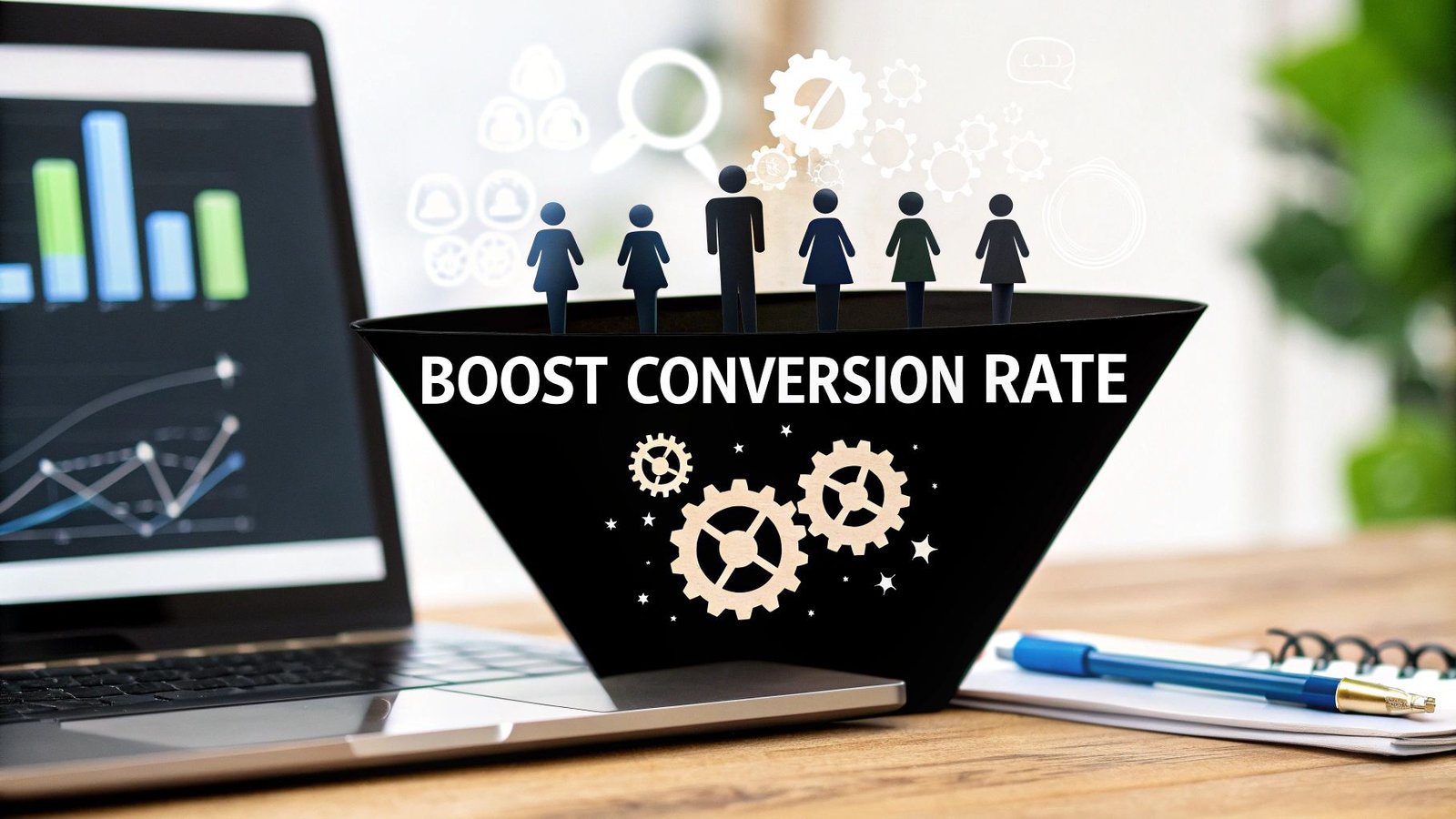Your lead to sale conversion rate is one of the most honest metrics in your business. It’s the percentage of leads who actually become paying customers over a set period. Think of it as the ultimate health check for your entire sales and marketing machine, showing you exactly how well you turn initial interest into real revenue.
Decoding Your Sales Engine's Health

Let's imagine your sales process is a journey. At the starting line, you have a big crowd of people who've raised their hands—these are your leads. The finish line is the moment they make a purchase. Your lead-to-sale conversion rate simply tells you how many of those people who started the journey actually made it to the destination.
If 100 people start that journey but only three cross the finish line, your conversion rate is 3%. This single number is incredibly powerful. It measures the combined effectiveness of every single marketing campaign, sales call, and product demo along the way. It’s the final grade on your report card, showing how well your marketing and sales teams are really working together to hit that all-important goal: revenue.
Why This Metric Is a Game-Changer
Tracking this rate isn’t just about crunching numbers. It’s about getting a clear, unfiltered view of your business’s performance. It helps you answer the tough questions that actually drive growth and smart strategy.
Without it, you’re flying blind. Sure, you might be generating thousands of leads, which looks great on a dashboard, but if hardly any of them are converting, you're just burning through your budget. This metric shines a bright light on the weak spots in your process.
The formula is beautifully simple, but the insight it gives you is profound. It creates a baseline for understanding performance and setting realistic targets for growth.
(Total Number of Sales / Total Number of Leads) x 100 = Lead to Sale Conversion Rate
By keeping a close eye on this number, you can spot problems before they get out of hand. Did the rate suddenly drop? Maybe the lead quality from that new marketing campaign is poor, or perhaps there's a bottleneck in your sales team's follow-up process. On the flip side, a steady increase is concrete proof that your strategies are clicking and your teams are in sync.
A Quick Overview of the Concept
To make sure we're on the same page, let’s quickly break down the core components. This isn't just a metric for the C-suite; it’s a vital tool for everyone involved in growing the business, from marketing coordinators to senior sales reps.
Keep in mind, these rates vary wildly depending on your industry and how much you're selling your product for. The average often hovers around 5%, meaning for every 100 leads, about five become customers. For instance, a low-cost SaaS subscription will naturally have a higher conversion rate than a high-ticket item like luxury real estate, which involves a much longer and more considered decision-making process. For a deeper dive, you can explore some fascinating research on lead conversion benchmarks.
For a quick reference, this table sums up the key points.
Lead to Sale Conversion Rate at a Glance
| Component | Description |
|---|---|
| What it Measures | The end-to-end efficiency of your sales funnel, from the very first point of contact to the final closed deal. |
| Why it Matters | It directly ties marketing activities to revenue, helps you forecast sales, and pinpoints where your sales process is breaking down. |
| Who Should Track It | Sales leaders, marketing managers, and any executive responsible for the financial health and growth of the company. |
Getting a firm grasp on this metric is the foundational first step toward building a truly optimized customer acquisition strategy.
How to Accurately Calculate Your Conversion Rate
Before you can improve your lead-to-sale conversion rate, you have to know how to measure it properly. The basic formula seems simple enough, but the devil is always in the details. Getting this right is the only way to avoid making big decisions based on bad data.
At its core, the calculation is refreshingly straightforward:
(Total Number of Sales / Total Number of Leads) x 100 = Lead to Sale Conversion Rate
So, if your team brought in 500 leads last quarter and managed to close 25 of them, your math would look like this: (25 / 500) x 100. That gives you a 5% lead-to-sale conversion rate.
This number is your starting point—your baseline. But its true value hinges on how you define the terms.
Establish Consistent Definitions
The single biggest mistake I see teams make is playing fast and loose with the definitions of "lead" and "sale." It sounds trivial, but it's not.
Think about it: does a "lead" mean anyone who downloaded a whitepaper? That’s a Marketing-Qualified Lead (MQL). Or does it only count after they’ve had a conversation with a sales rep and been properly vetted? That’s a Sales-Qualified Lead (SQL).
Choosing one over the other will drastically change your final number. A rate based on all MQLs will always look much lower than one using only high-intent SQLs. To get everyone on the same page, your sales and marketing teams need to sit down and agree on a few key things:
- What constitutes a lead? Pinpoint the exact action or qualification step that officially turns a contact into a "lead" for this specific calculation.
- What defines a sale? Is it when the contract is signed? When the first payment hits the bank? Or after the customer is fully onboarded?
- What is the time period? Are you looking at this monthly, quarterly, or annually? Pick one and stick with it to spot trends over time.
Without this alignment, you end up with marketing celebrating a ton of "leads" that sales knows are duds, which just creates friction and messy reports.
A Practical B2B Software Example
Let's see how this plays out with a fictional SaaS company, "InnovateTech."
The leadership team at InnovateTech gets together and agrees on these definitions for their quarterly reporting:
- Lead: A prospect who fills out the "Request a Demo" form on the website (a clear SQL).
- Sale: A customer who signs an annual subscription contract.
- Time Period: Q3 (July 1 – September 30).
Over the course of Q3, their marketing campaigns drove 320 demo requests. The sales team got to work, and by the end of September, they had secured 24 new annual contracts.
Let's plug that into the formula:
- Total Sales = 24
- Total Leads = 320
(24 / 320) x 100 = 7.5%
So, InnovateTech’s lead-to-sale conversion rate for Q3 is 7.5%. This isn't just a vanity metric; it's a solid, reliable number they can trust. They can now compare it to their Q2 performance to see if their process is getting better and use it to build a more accurate forecast for Q4.
To see how this number fits into the bigger picture, you can find a ton of great info on sales funnel conversion rates. Ultimately, this kind of precise calculation is what separates guessing from making smart, strategic decisions.
What’s a Good Lead-to-Sale Conversion Rate, Anyway?
So you’ve run the numbers and calculated your lead-to-sale conversion rate. Great. Now what? You're staring at a percentage, let's say it's 5%. Is that a number worth celebrating, or is it a sign your sales funnel is leaking like a sieve?
Without context, that number is just a number. To find out what it really means, you need to see how you stack up against your industry. This is where benchmarks become your best friend.
A "good" conversion rate isn't one-size-fits-all. It changes wildly based on what you're selling, who you're selling it to, and how long they take to make a decision. A 2% conversion rate might be fantastic for a B2B company selling complex enterprise software, but that same 2% could signal big trouble for an e-commerce store selling t-shirts.
Take a look at the image below. It paints a clear picture of how conversion rates naturally drop off at each step of a typical sales funnel, from the first website visit all the way to the final sale.

As you can see, losing people at each stage is normal. The real goal is to plug the biggest leaks and optimize every small step along the way.
Why Context Is Everything
So, why the huge differences between industries? It’s not random. A few key factors are at play, and understanding them helps you set realistic goals and figure out where things might be going wrong. It's like comparing the fuel efficiency of a sports car to a cargo truck—you wouldn't expect them to perform the same because they’re built for completely different jobs.
Here’s what’s really driving those differences:
- Price and Value: It’s simple, really. The more something costs, the more people hesitate. A decision involving thousands of dollars and multiple stakeholders will always have a lower conversion rate than an impulse buy for a pair of socks.
- Sales Cycle Length: Time is a huge factor. A B2C e-commerce sale can happen in minutes. A complex B2B deal, on the other hand, might take six months or more to close, which naturally stretches out the conversion timeline and affects the rate.
- Lead Quality and Source: Where did the lead come from? A referral from a happy customer is gold and will likely convert at a much higher rate. A lead from a cold email blast or a generic social media ad? Not so much.
- Market Competition: In a crowded market, customers have endless choices. Brands have to fight harder for every single sale, which often pushes conversion rates down for everyone involved.
Benchmarks Across Different Sectors
Okay, let's talk real-world numbers. While every business is unique, these averages give you a solid yardstick to measure your performance against. For example, the professional services industry often sees pretty good conversion rates from paid search, averaging around 3.2%, because buyers are actively searching for a solution to a problem they already have.
E-commerce is a completely different ballgame. The global average e-commerce conversion rate usually lands somewhere between 2% and 4%. But even that varies a lot. Personal care products (6.8%) and food & beverages (4.9%) tend to do well, while industries like fashion, jewelry, and home decor often sit below average, somewhere between 1.4% and 1.9%. Digging into specific e-commerce benchmarks can give you a much clearer picture of your specific niche.
The goal isn't to hit some magic, universal number. It's about figuring out what's realistic for your business model, your price point, and your market.
To put all this into perspective, here’s a quick look at how wildly "good" can vary across a few major industries. Use this to set targets that actually make sense for your team.
Average Conversion Rate Benchmarks by Industry
| Industry | Average Conversion Rate | Key Influencing Factors |
|---|---|---|
| B2B SaaS | 3-8% | Product complexity, trial vs. demo models, contract length. |
| Professional Services | 2-5% | High-trust requirement, long sales cycles, relationship-based selling. |
| E-commerce (Low-Cost) | 2-4% | Impulse buys, seasonal promotions, simple purchase process. |
| Real Estate | 1-2% | Extremely high value, long-term commitment, offline interactions. |
By using these benchmarks as a guide, you can start looking at your conversion rate as more than just a metric. It becomes a diagnostic tool—a real indicator of how healthy and efficient your entire sales process truly is.
Key Factors That Influence Your Conversion Rate

Your lead-to-sale conversion rate isn't just another number on a dashboard; it’s a direct reflection of your company's health. It tells a story about how well your marketing, sales, and product are working together. To get that number moving in the right direction, you have to understand the core forces pulling the strings behind the scenes.
Think of it like a recipe. If you get the measurements wrong or leave out a key ingredient, the final result will fall flat. For conversions, there are four essential ingredients: the quality of your leads, the efficiency of your sales process, your product-market fit, and the overall customer experience. Let's dig into each one.
The Quality of Your Leads
Let's get one thing straight: not all leads are created equal. This is probably the single biggest factor impacting your conversion rate. You could have the best sales team on the planet, but if they're talking to people who don't need or can't afford your product, they're just spinning their wheels.
High-quality leads are people with a real problem your solution can fix. They have the budget, the authority to buy, and a clear reason to act now. Getting these people into your pipeline starts with sharp, targeted marketing that speaks directly to their biggest headaches.
Chasing a high volume of low-quality leads is like trying to fill a leaky bucket. You’ll be busy, but the bucket will never get full. The real goal isn't just more leads, it's better leads.
This is where solid lead qualification becomes so important. You need a process to quickly sort the serious buyers from the window shoppers. Focusing your energy here means your team spends its time on deals that actually have a chance of closing. You can learn more about how to qualify sales leads to make sure you're on the right track.
The Efficiency of Your Sales Process
The moment a good lead comes in, the clock starts ticking. How fast and how well your sales team engages with them can make or break the deal. A slow, disorganized, or confusing sales process is a guaranteed conversion killer.
Ask yourself these questions:
- What's our response time? The data is clear. Your chances of converting a lead plummet after the first five minutes. Speed is everything.
- Is our follow-up game strong? One email and a prayer won't cut it. You need a structured follow-up plan that offers value at every touchpoint.
- Do our reps have the right tools? A good CRM and solid sales materials aren't luxuries; they're necessities for keeping your team organized and effective.
A truly smooth sales process removes all the friction, making it simple for your team to sell and even easier for your prospects to buy. Every delay is a chance for them to get distracted and check out a competitor.
The Strength of Your Product-Market Fit
You can nail lead quality and have a killer sales process, but if your product doesn’t solve a painful problem for a specific audience, you’re going to struggle. Product-market fit is that magic moment when a customer realizes your solution is exactly what they've been searching for.
When you have a strong fit, selling feels less like persuading and more like guiding. The value is obvious. The messaging just clicks. Customers get it. Without that fit, your sales team is stuck in an uphill battle, trying to manufacture demand where it doesn't really exist. This is a huge deal—after all, 73% of companies with "above average" customer experience perform better financially than their competition.
The Simplicity of the Customer Experience
Every single interaction a prospect has with your brand—from their first click on your website to the final contract signature—shapes their decision to buy. The entire customer journey needs to be smooth, easy, and positive.
Even something as simple as your website's speed is a silent killer. Pages that load in just one second see conversion rates 2.5 times higher than those that take five seconds. A slow site can lose you the sale before a rep ever says hello.
This goes for everything else, too. Is your pricing page confusing? Is the contracting process a nightmare of paperwork? Can people find answers to basic questions without having to dig? Every point of friction is an off-ramp from your sales funnel. By focusing on these four pillars, you can find the weak spots and build a sales engine that truly works.
Actionable Strategies to Improve Your Conversion Rate
https://www.youtube.com/embed/FGlqxkpYVMs
Knowing your lead-to-sale conversion rate is one thing. Actually improving it is where the real work begins. Moving that number requires a deliberate, focused effort that bridges the gap between your marketing and sales teams.
There's no magic bullet here. The secret is making small, targeted improvements at the most critical points in your funnel. These are practical, real-world strategies that will give you a clear roadmap to turn more of those hard-won leads into paying customers.
Refine Your Lead Scoring Model
One of the biggest mistakes I see is sales teams treating every single lead with the same level of urgency. That’s a fast track to burnout and missed opportunities. The solution is a solid lead scoring model.
Think of it as a bouncer for your sales pipeline. It’s an automated system that assigns points to leads based on who they are and what they do, letting your team focus their precious time on the prospects who are genuinely ready to talk.
To build a model that actually works, you need to score based on a few key factors:
- Demographic Fit: How closely does this lead match your Ideal Customer Profile (ICP)? Assign points for things like company size, industry, job title, and location.
- Behavioral Signals: What actions are they taking? A visit to your pricing page or a demo request is a massive signal—it's worth way more points than just a blog view.
- Engagement Level: Are they consistently interacting with you? Track email opens, webinar attendance, and content downloads. A pattern of engagement shows they’re genuinely interested.
The key is to constantly review which leads actually close and adjust your scoring thresholds accordingly. This creates a feedback loop that makes your model smarter and more accurate over time.
Implement Automated Lead Nurturing
Here’s a hard truth: most of your leads aren't ready to buy the second they find you. Not even close. This is precisely why lead nurturing is so critical. It’s all about building a relationship and providing value before you ever ask for the sale.
You're guiding them, not pushing them. Automated email sequences are your best friend here, letting you stay top-of-mind by delivering the right message at the right time—all without a single manual touch from your sales team.
Imagine a new lead downloads a whitepaper. You could automatically send them a series of emails. The first shares a related case study. The second invites them to an upcoming webinar. The third finally introduces the idea of a sales chat. This approach warms them up and qualifies their interest at the same time.
For a deeper dive, check out these powerful B2B lead nurturing strategies to help you build out effective campaigns.
Optimize Your Sales Scripts and Process
When a lead is finally ready to talk to a human, that interaction has to be seamless. A clunky sales process or a tired, robotic script can undo all your hard work in a matter of minutes. Your goal is to make buying from you feel easy and compelling.
Start by listening to your team's call recordings. Do your reps nail the value proposition in the first 30 seconds? Are they asking smart, insightful questions, or just running through a checklist? You'll quickly spot patterns and weaknesses.
Next, give your team a flexible script that’s more of a playbook than a word-for-word mandate. It should include:
- A Strong Opening: Hook them immediately by referencing their specific problem.
- Powerful Questions: Dig deep to uncover their real challenges and goals.
- Benefit-Driven Statements: Always connect your features back to solving their problems.
- A Clear Call-to-Action (CTA): Never end a conversation without a clear next step.
Finally, dive into your CRM data to find the bottlenecks. Where do deals get stuck? Is it after the discovery call? At the proposal stage? Finding these friction points shows you exactly where your team needs more coaching or better resources to get deals over the line.
Common Conversion Tracking Mistakes to Avoid

Look, even the most brilliant strategy to improve your lead to sale conversion rate will crumble if you can't trust your data. When tracking is flawed, you're flying blind. You end up celebrating wins that never happened or trying to fix problems that don't exist. It’s like trying to navigate a ship with a broken compass—you’re definitely moving, but probably straight into an iceberg.
So many teams stumble into the same old traps, completely undermining their efforts. The good news? These mistakes are easy to avoid with a bit of discipline. Getting your tracking right is the bedrock of making smart decisions that actually grow revenue.
Using Inconsistent Definitions
This one is the classic, and it happens all the time. Marketing and sales aren't on the same page about what a "lead" or a "sale" even means. Marketing is high-fiving over 1,000 new newsletter signups they call "leads," while sales is staring at their empty pipeline wondering where the demo requests are.
When the definitions don't match, the data is garbage. You can't calculate a real conversion rate, and you end up with friction between two teams that should be working together.
The Fix: Get everyone in a room (virtual or otherwise) and create a shared "data dictionary." Nail down exactly what a Marketing Qualified Lead (MQL), a Sales Qualified Lead (SQL), an Opportunity, and a Closed-Won Deal look like. When everyone speaks the same language, the numbers finally start to make sense.
Ignoring Where Your Leads Come From
Can you confidently say where your best customers come from? If not, you're almost certainly wasting money. Failing to track lead sources means you have no clue which channels—be it organic search, paid ads, or social media—are bringing in the leads that turn into actual paying customers.
Without this insight, you can't double down on what’s working or pull the plug on what's not. You might be pouring your budget into a channel that generates tons of junk leads, which absolutely torpedoes your conversion rate.
Proper attribution isn't just about the last click. You need to track the whole journey. Start by consistently using UTM parameters on all your campaigns. This gives your analytics the breadcrumbs it needs to trace every sale back to its true origin.
Focusing Only on the Final Number
Staring at your final lead-to-sale conversion rate is like only looking at the final score of a football game. It tells you if you won or lost, but it doesn't tell you why. The real story is in the plays—the micro-conversions happening at every single stage of your funnel.
To understand what’s really going on, you have to break it down and track the conversion rate from one stage to the next:
- Lead to MQL Rate: Are we turning raw interest into properly qualified leads?
- MQL to SQL Rate: Is marketing handing off solid, sales-ready prospects?
- SQL to Opportunity Rate: Can the sales team turn those conversations into real deals?
- Opportunity to Sale Rate: How effective is your team at closing?
When you analyze the funnel this way, the bottlenecks become glaringly obvious. A poor MQL to SQL rate, for example, points to an issue with marketing's lead quality, not sales' inability to close. By sidestepping these common mistakes, you’ll build a tracking system that gives you clarity, not just more confusing data.
Got Questions? We’ve Got Answers.
When you start digging into your lead-to-sale conversion rate, a few questions always pop up. It's completely normal. Here are the straightforward answers to the questions we hear most often from sales and marketing leaders.
How Often Should We Be Measuring This?
The simple answer? It really depends on how long it takes to close a deal at your company.
If you have a short sales cycle—think e-commerce or many B2C services—looking at this monthly is perfect. It gives you a regular pulse on performance and lets you see how new campaigns are doing without getting lost in the day-to-day static.
But for those with longer sales cycles, like most B2B SaaS or big-ticket services, a quarterly review makes a lot more sense. This wider view smooths out the inevitable delays between a new lead and a signed contract, giving you a far more reliable and meaningful picture of your performance.
What's the Difference Between "Lead Conversion" and "Sales Conversion"?
This is a classic point of confusion, but the distinction is crucial. They measure two totally different stages of your funnel.
-
Lead Conversion Rate: This is all about the top of your funnel and is squarely a marketing metric. It tells you what percentage of people who visit your site or see your content actually raise their hand to become a lead (like by filling out a form).
-
Sales Conversion Rate: This one lives at the bottom of the funnel and belongs to the sales team. It measures the percentage of qualified leads that your team successfully turns into paying customers.
To put it simply, lead conversion shows how good you are at sparking initial interest. Your lead-to-sale conversion rate shows how good you are at turning that interest into actual money.
What Are the Best Tools to Track All This?
You don't need a complicated and expensive tech stack to get a handle on this. The one non-negotiable tool is a solid Customer Relationship Management (CRM) platform.
Your CRM—whether it’s Salesforce, HubSpot, or Zoho—is your single source of truth for everything sales-related. It’s where you can follow a lead's entire journey, from their very first click to the final closed deal, making it absolutely essential for an accurate conversion rate calculation.
Once you have a CRM in place, you can add tools like marketing automation and analytics platforms. These help you connect the dots and see exactly which channels are bringing in the leads that actually close, giving you a much smarter way to invest your budget.
Ready to fill your pipeline with high-quality prospects? The Nordic Lead Database offers the most extensive database of decision-makers and companies in the Nordics. Find your next customer today at https://nordicleaddatabase.com.
